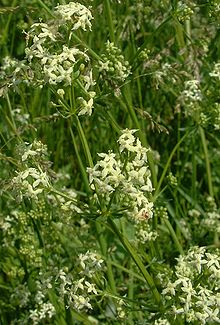
Summary
Galium album, the white bedstraw or hedge bedstraw, is a herbaceous annual plant of the family Rubiaceae.[3][4]
| White bedstraw | |
|---|---|

| |
| Scientific classification | |
| Kingdom: | Plantae |
| Clade: | Tracheophytes |
| Clade: | Angiosperms |
| Clade: | Eudicots |
| Clade: | Asterids |
| Order: | Gentianales |
| Family: | Rubiaceae |
| Genus: | Galium |
| Species: | G. album
|
| Binomial name | |
| Galium album | |
| Synonyms[1][2] | |
| |
Description edit
The stems can grow to at least 150 cm and are more or less erect with ascending branches. The stem is square in section with slight flanges. The plant is relatively hairless with shiny leaves and stem. Flowers are white or yellowish.[5] The fruit are hairless.[6][7]
Habitat and distribution edit
Galium album is widespread over much of Europe, being native to a large region from Britain to Morocco, east to Turkey and Western Siberia. It is naturalized in Ireland, Scandinavia, Greenland and South Australia.[1] It is found in pastures, grassy banks, etc., especially on dry calcareous soils. In Britain, G. album is local in lowland England, rare in the north and very rare in Scotland.[5]
Subspecies edit
Four subspecies are currently (May 2014) recognized:[1]
- Galium album subsp. album - most of the range of the species
- Galium album subsp. prusense (K.Koch) Ehrend. & Krendl - Greece, Bulgaria, Crimea, Turkey, Caucasus
- Galium album subsp. pycnotrichum (Heinr. Braun) Kren - from Poland south to Greece and Turkey
- Galium album subsp. suberectum (Klokov) Michalk - Carpathian Mountains of western Ukraine
References edit
- ^ a b c Kew World Checklist of Selected Plant Families
- ^ The Plant List
- ^ Miller, Philip. 1768. Gardeners Dictionary, Edition 8. London, n. 7
- ^ Ehrendorfer, Friedrich & Krendl, Franz Xaver. 1974. Botanical Journal of the Linnean Society 68(4): 270
- ^ a b Clapham, A. R., Tutin, T. G. and Warburg, E. F. (1987). Excursion Flora of the British Isles. Cambridge: Cambridge University Press. ISBN 0-521-23290-2. p. 302.
- ^ Hennedy, Roger (1891). The Clydesdale Flora. Glasgow: Hugh Hopkins. p. 97.
- ^ Michalková, Eleonóra. 1993. Biología, Bot. (Bratislava) 48(1): 48
External links edit
- USDA Plants Profile: Galium album
- "Galium album". Integrated Taxonomic Information System.
- Biolib
- INDEX SYNONYMIQUE DE LA FLORE DE FRANCE
- Tropicos
- Altervista Flora Italiana


